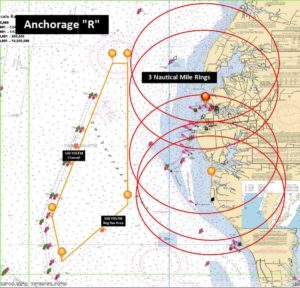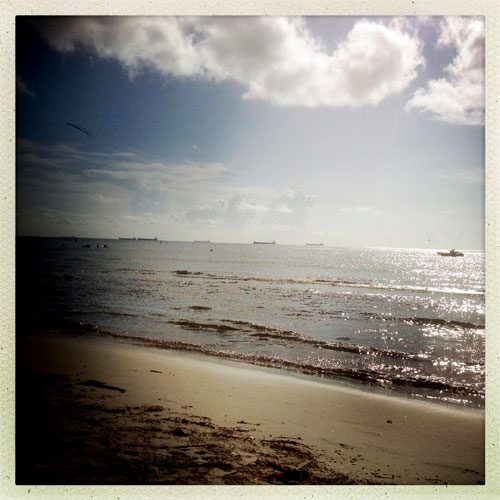“Right now, you know this, the town is moving in the right direction, and it’s happening right before our eyes. So, I’m not a big fan of the ships.” – Councilman Andy Buchholz, in a conversation with the Mirror.
The U.S. Coast Guard has proposed a pentagonal parcel of water deep enough for the cargo ships that wait to pick up their coal in port. It’s farther offshore than ships have been anchoring in the past few years – 3 nautical miles from where the town of Cape Charles runs into the beachfront, and 5 nautical miles from beaches at Kiptopeke and Butlers Bluff. The anchorage could hold as many as 30 ships.
In the last few years, the Cape Charles economy has become more and more dependent on tourism. Buchholz’s concern is that these large vessels could jeopardize the town’s livelihood. We are uniquely located on the Eastern Shore and are blessed with one of the very best sunsets in the world. In fact, our sunsets are what we are becoming known for. Now, as you gaze west, the horizon is dotted with collier vessels, either quarantined or waiting to enter port to gather coal. Not something you would put on a postcard.

Understandably, complaining about your view is a first world problem, however, the contamination of our waters is a real concern. Our local economy is highly dependent on having a clean, healthy beach. This season, we have had several closing due to waterborne disease. We understand that the closing is more related to heavy rains and runoff, yet anecdotal evidence and opinions are that the water does not seem as clean. Testing for disease is a way to be sure no one gets sick from swimming in the water, but what about the general quality–is it clear, is it free of debris and unknown flotsam and jetsam?
While these vessels are anchored offshore, how can we be sure they are not releasing contaminants into the water?
Ballast water discharges by large ships can have a negative impact on the marine environment.
Bulk cargo carriers use a huge amount of ballast water, which is often taken on in the coastal waters in one region after ships discharge wastewater or unload cargo, and discharged at the next port of call, wherever more cargo is loaded. Ballast water discharge typically contains a variety of biological materials, including plants, animals, viruses, and bacteria. These materials often include non-native, nuisance, invasive, exotic species that can cause extensive ecological and economic damage to aquatic ecosystems along with serious human health problems.
Pollution from large ships is also generated by diesel engines that burn high sulfur content fuel oil, also known as bunker oil, producing sulfur dioxide, nitrogen oxide and particulate, in addition to carbon monoxide, carbon dioxide, and hydrocarbons. Diesel exhaust has been classified by EPA as a likely human carcinogen. EPA recognizes that these emissions from marine diesel engines contribute to ozone and carbon monoxide nonattainment (i.e., failure to meet air quality standards), as well as adverse health effects associated with ambient concentrations of particulate matter and visibility, haze, acid deposition, and eutrophication and nitrification of water. EPA estimates that large marine diesel engines accounted for about 1.6 percent of mobile source nitrogen oxide emissions and 2.8 percent of mobile source particulate emissions in the United States in 2000 (source Wikipedia).
In 2016 the IMO has made new sulfur regulations which must be implemented by larger ships by 2020.
Many of these vessels are being quarantined until they are cleared to enter a US Port.
In recent years, the quarantine and isolation regulations have made it easier for the CDC to require a ship clearing or departing a foreign port bound for the United States to obtain a bill of health from the US consular officer for that port setting forth the sanitary history of the vessel. The CDC can also suspend, in whole or in part, entries and imports from designated foreign countries or places. This would be done when the CDC Director determines that the risk of introduction of a disease into the United States is increased by the introduction of persons or property from such foreign countries or places. Operators of ships on international voyages are required to report deaths or illnesses prior to arrival. Operators are required to report not just persons on board with a designated communicable disease, but persons defined as ill, meaning a person who: (1) has a temperature of 100.4°F (38°C) or greater accompanied by one or more of the following: rash, swelling of lymph nodes or glands, headache with neck stiffness or changes in level of consciousness or cognitive function; (2) has a temperature of 100.4°F (38°C) or greater that has persisted for at least 48 hours; (3) has more than common diarrhea; (4) has severe bleeding, jaundice or severe persistent cough accompanied by bloody sputum, respiratory distress or a temperature of 100.4°F (38°C) or greater; or (5) displays other symptoms or factors that are suggestive of communicable disease.
Ships arriving in a US port with a serious disease on board are required to provide advance notification. The ship may be required to undertake certain sanitary measures and to exercise various controls over all persons on board to prevent them from serving as disease vectors potentially infecting the local populace. The closest we have come recently to a general quarantine affecting the maritime industry was during the 2002 SARS epidemic, which heavily impacted southeast Asia. A future pandemic, whether the result of avian flu or otherwise, may see widespread implementation of quarantine measures and fly of the quarantine flag.
In the past few years, the number of whales stranded in or around the mouth of the bay due to impact with large vessels has been on the rise. Marine mammals, such as whales risk being struck by ships, causing injury and death. For example, if a ship is traveling at a speed of only 15 knots, there is a 79 percent chance of a collision being lethal to a whale.
One notable example of the impact of ship collisions is the endangered North Atlantic right whale, of which 400 or less remain. The greatest danger to the North Atlantic right whale is an injury sustained from ship strikes. Between 1970 and 1999, 35.5 percent of recorded deaths were attributed to collisions. During 1999 to 2003, incidents of mortality and serious injury attributed to ship strikes averaged one per year. In 2004 to 2006, that number increased to 2.6. Deaths from collisions have become an extinction threat. The United States’ National Marine Fisheries Service (NMFS) and National Oceanic and Atmospheric Administration (NOAA) introduced vessel speed restrictions to reduce ship collisions with North Atlantic right whales in 2008.

The anchorage proposed by Coast Guard, even as they move it further away, still poses a threat to our health and well-being.
On Tuesday, July 10 the Coast Guard will hold two public meetings on the status of proposed anchorages off the coast of Cape Charles. The first session runs from 1:00 to 3:00 pm, with the second session beginning at 6:00 pm. Both sessions will be in the Cape Charles Civic Center, located at 500 Tazewell Avenue. In the spring of 2016 a similar proposal was presented for public review and comment. The Coast Guard hosted a public meeting at the Civic Center that August. Numerous comments were received during that process. From those comments, the Coast Guard reviewed and revised the original proposal and developed a new one, which is now under public review and comment. There are many important matters to consider as part of this anchorage proposal review. The Coast Guard has prepared a summary document webpage and includes a link to leave a public comment. Public comments and any related material must be submitted by July 17. Please become familiar with the issues and participate in the public review and comment process.
If you cannot make the meetings, please Comment Here Now. Public comments and any related material must be submitted by July 17. It is important that the USCG receives public input on this matter.




New Anchorage off of Cape Charles? It doesn’t take a genius to figure out that this is not going to be of any benefit to this little town.
I’m hoping that the town will show up in force and reject this bonehead scenario presented by the Coast Guard. All you have to do is walk these beaches in the early morning to see this disgusting debris that is surfacing on the properties! It is time for the town to band together and say no to this disgusting proposal.
I totally agree! It is time we as citizens take a stand!
Wouldn’t it be better for Cape Charles and surrounding beaches if the anchorage was further offshore?
I like the ships being here. I think it is nice to have the changing scenery, especially at night. Do you really think the Government is going to listen to the citizens of a small vacation town because their sunset is blocked and move the anchorage? Won’t moving the anchorage further away from Norfolk cause more air pollution because the ship will have to travel a longer distance? As for the debris…The only debris I see on the beach is the trash left by the beach-goers and what washes down from the Susquehanna River, Baltimore and DC. I’ve been on these beaches for the past 20 years and have always seen coal washing, up nothing new.
Been combing the local beaches for twenty years.
Haven’t seen any increase in “unusual” trash since the coal ships arrived.
Know what I do see?
Mounds of black netting cut loose from the much touted aquaculture farms.
It’s a much more serious issue, aesthetically and environmentally but there’s them dollar$ to be had so…………………
A friend of mine walks the beaches pretty regularly in the evenings. According to her there is a lot of trash being left on the beach by the people that use the beach. Maybe the people using the beach need to be monitored a little better so that this will stop. I personally don’t use the beach anymore and haven’t for many years. Too many people go down into the water to pee. GROSS!
I always wondered why the Bay was so warm………;)
LOL @ YOU MIKE!
And soooo salty! LOL!
The beach looks soo much better than it did years ago! There use to be huge concrete sewer pipes that would carry the towns sewage into the harbor and onto the beach. Wouldn’t worry about someone peeing in the bay too much.
The trash from the ships MUST be drifting all the way around to the Seaside Barrier Islands because they are full of trash also.. We have picked up 39 balloons on each of of our trips walking on the island last week and 18 yesterday. They must be having a lot of events on those ships..graduations, birthday etc.